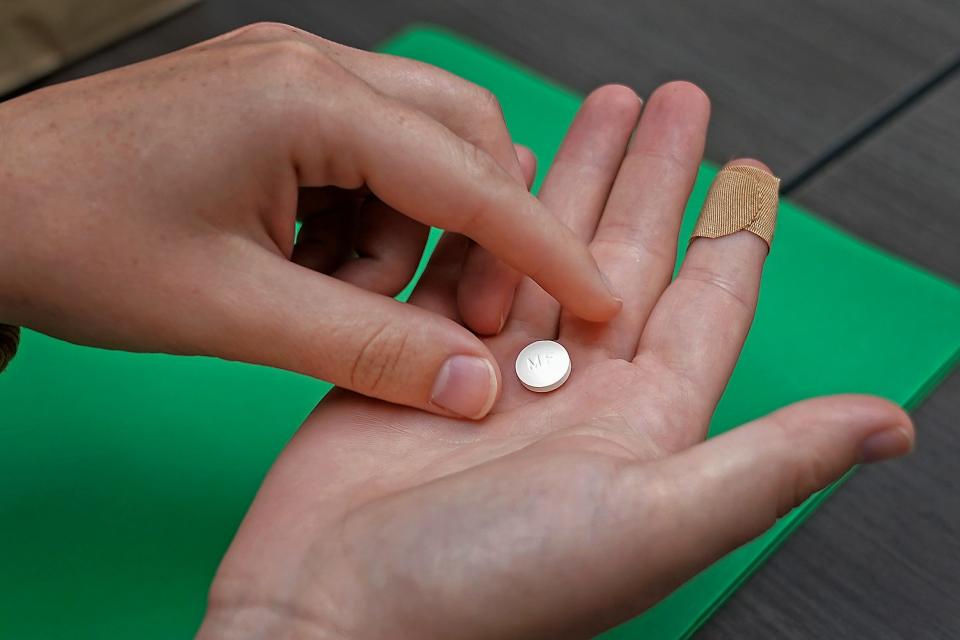The Supreme Court will hear arguments about mifepristone. What is the drug and how does it work?
The Supreme Court agreed Wednesday to review an appeals court decision regarding access to mifepristone, the abortion pill at the center of a monthslong legal battle.
Mifepristone, an oral drug, was pushed into the spotlight after the Supreme Court overturned Roe v. Wade, the 1973 decision that established a constitutional right to an abortion, in 2022. The drug is used in conjunction with misoprostol to terminate a pregnancy that's less than 70 days developed.
University of Southern California, San Francisco professor and gynecologist Daniel Grossman told USA TODAY the drug is one of the most effective, and chosen, means to terminate a pregnancy. It's about 87% to 98% effective and allows pregnant people to take the medication at home, with their partner or surrounded by family.
"Obviously with the Dobbs ruling, and the closure of clinics and abortion being banned and about 14 states, people living in those states in particular have fewer options," Grossman said.
Wednesday announcement is the latest step in a long legal saga. At issue for the Supreme Court are several restrictions the FDA lifted in 2016 and 2021. In 2016, the agency reduced the number of required clinical visits from three to one and allowed non-physicians, such as nurse practitioners, to prescribe and dispense mifepristone. In 2021, amid the COVID-19 pandemic, the FDA determined that the drug’s in-person dispensing requirement was no longer necessary, paving the way for the drug to be dispensed through the mail.
The high court is likely to issue an opinion in June, just as the 2024 General and Presidential Election shapes up across the country.
Here's what to know about mifepristone:
How does mifepristone work?
Mifepristone is taken first. About 24 to 48 hours after consuming it, a person takes misoprostol, the FDA said. After consuming the medication, a person's cervix dilates and their uterus contracts, which releases the embryo from the uterus. Grossman said the embryo discharges from the uterus in a similar matter to a miscarriage.
Dr. Colleen Denny, director of family planning services at New York University Langone Hospital of Brooklyn, said patients follow up with their doctors to make sure the pregnancy tissue passed, but said that can be done over telemedicine visits.
The National Library of Medicine said side effects can include vaginal bleeding, cramps, pelvic pain, headaches and vaginal burning, itching or discharge.
Mifepristone can't be used to terminate ectopic pregnancies, Grossman said.
Even before the Supreme Court struck down Roe, medication abortion accounted for more than half of all abortions in the United States, according to analysis by the Guttmacher Institute, a research and policy organization that supports abortion rights.
How has the legal saga over mifepristone played out?
The 5th U.S. Circuit Court of Appeals, based in New Orleans, ruled in August the FDA overstepped its authority with the drug, including allowing prescriptions for it to be filed by mail. Other actions shot down by the appeals court included requiring people to see doctors in person for the drug and prohibiting mail prescriptions.
The pill wasn't immediately restricted due to an April Supreme Court ruling allowing full access to the drug while litigation plays out in lower courts. That followed U.S. District Judge Matthew Kacsmaryk, of Texas, ruling that same month to stop the FDA's approval of mifepristone.
The Biden administration appealed in September, asking the Supreme Court to rule on the case.
"Study after study has shown that when mifepristone is taken in accordance with its approved conditions of use, serious adverse events are exceedingly rare," U.S. Solicitor General Elizabeth Prelogar told the Supreme Court in an appeal filed in September.
The Supreme Court declined to take up a separate case that challenged the FDA's underlying authority to approve the drug. That is likely a signal that, whatever the top court does, it is likely to focus only on restrictions to the drug − not its underlying and decadeslong approval.
"I would hope that the pharmaceutical industry will be following this case very carefully and, hopefully, voicing its concerns that this could really upend our whole drug regulatory process," Grossman said.

How can someone get mifepristone, misoprostol?
Both medications require prescriptions. The FDA has allowed oral abortion medication to be available via mail and prescribed during telehealth appointments since December 2021.
Attorney General Merrick Garland said in June 2022 states cannot ban mifepristone "based on disagreement with the FDA's expert judgment about its safety and efficacy."
Is mifepristone dangerous?
The FDA says the drug is safe to use when used as directed.
"As with all drugs, the FDA continues to closely monitor the postmarketing safety data on mifepristone for the medical termination of pregnancy," the administration said.
Contact reporter Krystal Nurse at knurse@USATODAY.com. Follow her on X, the platform formerly known as Twitter, @KrystalRNurse.
Contributing: Christine Fernando, USA TODAY.
This article originally appeared on USA TODAY: Supreme Court to hear arguments about mifepristone. What is the drug?

